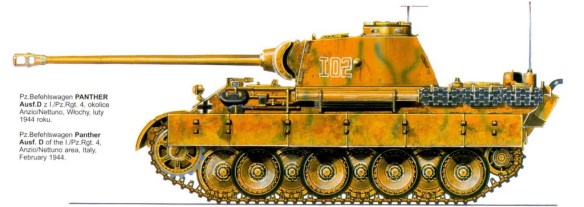Throughout the nine months of the Model D Panther production run in 1943, German firms made about ten per cent of them into command tanks, or Befehls Panthers. These vehicles mainly served as commander’s and adjutant’s vehicles at company, battalion and even regimental levels. The Command Panther was simply a slightly modified standard Panther with ammunition stowage reduced from 79 to 64 rounds to make space for the powerful communications equipment and associated systems they carried. MAN alone completed 63 of these vehicles between January and August 1943. Model D, A and G Command Panthers came in two similar but distinct forms, although both versions shared many common features, such as an additional generator set, the absence of the co-axial turret machine gun, and the addition of three tubes fitted onto the hull sides in which spare antennae rods were housed.
The standard Sdkfz 267 Command Panther, irrespective of whether it was a Model D, A or G, featured the standard battle tank communications device, the Fu 5 10-watt transmitter and ultra-short wavelength receiver. Unlike on the combat tank, however, this device here worked through a two-metre-Iong rod antenna usually mounted on the right turret rear, adjacent to the commander’s cupola, in addition to the standard rod antennae mounted on the left hull decking behind the turret. In normal tactical conditions, operators could expect to obtain a range of eight kilometres with this device. In addition, the Sdkfz 267 tank also mounted the powerful Fu 8 long-range device. This 30-watt transmitter and medium wavelength receiver operated on the frequency band 0.83-3.0MHz, and worked through a distinctive 1.4 metre star antenna normally mounted on the hull roof at the rear of the vehicle. The Fu 8 could communicate up to a maximum range of 65km, sufficient to secure effective communications with regimental and divisional staffs in almost every conceivable tactical situation.
In total, throughout the war, the Germans delivered 350 Sdkfz 267 Command Panthers, including roughly 75 Model D and 200 Model A versions. In addition, it should be remembered that front-line troops could convert standard Panthers to command versions in the field with a dedicated conversion kit if their command vehicles had been destroyed and no replacement was forthcoming. The Sdkfz 267 Command Panther proved highly effective; by retaining the standard Panther gun and armour, it could engage the enemy directly while simultaneously controlling the actions of the unit it commanded. Moreover, by looking like the standard Panther tank its battlefield survivability improved, as striving to knock out enemy command tanks had always been a preferred tactic of armoured warfare.
The much less common Sdkfz 268 ‘Flivo’ Befehls Panther command variant was a dedicated air-ground liaison vehicle used for arranging tactical air support for Panther units. Rather than using the Fu 8, this vehicle mounted the Fu 7 device in addition to the standard Fu 5. The Fu 7 was a 20-watt transmitter and ultrashort wavelength receiver that operated on the frequency band 42.1-47.8MHz through a 1.4 metre rod antenna normally mounted on the rear hull roof. In theory, the two (or possibly three) rod antennae of the Sdkfz 268 easily distinguished this vehicle from standard Panther combat tanks (with only one rod antenna) and the Sdkfz 267 Command Panther with one star and either one or two rod antennae. However, pictorial evidence reveals that the Sdkfz 267 and 268 command vehicles often featured non-standard positioning of their aerials, making definite identification problematic. The ‘Flivo’ Command Panther remained a very rare vehicle, with only 40 being completed by the end of the war. Indeed, given the increasingly adverse strategic situation under which the Luftwaffe laboured during 1944-45, it remains unclear whether many such vehicles actually fulfilled their intended air-ground liaison role, as German tactical air support by this time was extremely limited at best. Moreover, as both the Command Panther variants carried two mounting devices onto which the Fu 7 or Fu 8 could each be fitted, it seems highly likely that the Germans refitted some Sdkfz 268 ‘Flivo’ vehicles as much needed standard command tanks by simply replacing the Fu 7 device with the Fu 8 set.
